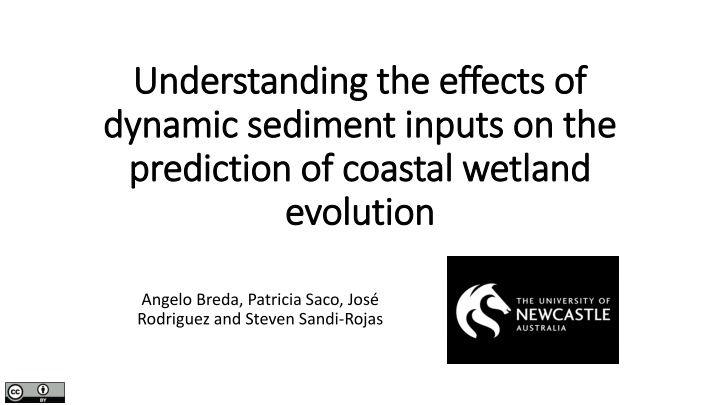
Understanding the Effects of Dynamic Sediment Inputs on Coastal Wetland Evolution
Explore the impact of dynamic sediment inputs on the prediction of coastal wetland evolution through a study by Angelo Breda, Patricia Saco, Jos Rodriguez, and Steven Sandi-Rojas. The research focuses on long-term suspended solid concentration, eco-geomorphological modeling, and results related to accretion, mangrove area, and saltmarsh area variations.
Download Presentation

Please find below an Image/Link to download the presentation.
The content on the website is provided AS IS for your information and personal use only. It may not be sold, licensed, or shared on other websites without obtaining consent from the author. If you encounter any issues during the download, it is possible that the publisher has removed the file from their server.
You are allowed to download the files provided on this website for personal or commercial use, subject to the condition that they are used lawfully. All files are the property of their respective owners.
The content on the website is provided AS IS for your information and personal use only. It may not be sold, licensed, or shared on other websites without obtaining consent from the author.
E N D
Presentation Transcript
Understanding the effects of Understanding the effects of dynamic sediment inputs on the dynamic sediment inputs on the prediction of coastal wetland prediction of coastal wetland evolution evolution Angelo Breda, Patricia Saco, Jos Rodriguez and Steven Sandi-Rojas
Introduction Introduction Long-term frequent time series of suspended solid concentration (SSC) are usually not available Many simulations using eco-geomorphological (EGM) models adopt a constant sediment input over the year Sentinel-2/C2RCC provides up to 4 SSC estimates in a 10-days windows Storms lead to strong changes in SSC SNAP - ESA Sentinel Application Platform v7.0, http://step.esa.int
Methods Methods Eco-Geomorphological (EGM) modelling framework developed and calibrated for the Hunter River estuary (SE Australia; Rodriguez et al. (2017)) 8 trimesters to represent different tide/sediment conditions (TSM from Sentinel-2/CR2CC data) Sea level rise from 2010 to 2060 (~ 0.3 m) Hypothetical Tidal-Flat: 150 m wide (long-shore) 1 km long (distance from tide-input creek) 0.001 m/m Inner channel at north edge Sea Level Rise Hydrodynamic: Water depths, velocity, discharge Ecologic: Vegetation Sediment Transport: Suspended solid concentration establishment, migration and competition MHTWL Geomorphologic: Soil elevation Adapted from: Rodriguez, J. F., et al. (2017). "Potential increase in coastal wetland vulnerability to sea-level rise suggested by considering hydrodynamic attenuation effects." Nature Communications 8.
Results: Accretion Results: Accretion Accretion is strongly related to sediment concentration Dynamic sediment input may increase accretion in sediment-rich environments, and decrease in poor ones Ratios = (Dynamic Static) Static
Results: Mangrove Area Results: Mangrove Area Mangrove area is less sensible to changes in sediment concentration and maximum water depth Difference in mangrove area tends to increase with time regarding the type of SSC input 2020 2060
Results: Saltmarsh Area Results: Saltmarsh Area Saltmarsh area were the less affected by changing the type of sediment input 2020 2060






















